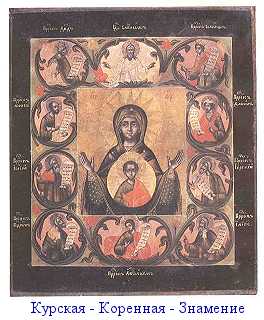Kursk Korennaya - The Sign
This icon was invented in the forest on the bank of the Tuskar River some 27 versts from the site of the city of Kursk devastated by Khan Batu. In 1295, a hunter stumbled upon an icon lying face down on the roots of a tree. He picked it up and saw a clear spring gushing from the ground, The hunter told the people of the nearby town of Rylsk about his find. Soon the icon, which attracted a stream of pilgrims, began to work various miracles. Prince Vassily Shemyaka of Rylsk had the icon moved to his capital, but failed to come to meet it himself and on the same day he was struck with sudden blindness. Having realized that this was a punishment for his guilt, the Prince repented and went to pray before the icon. His prayers brought him a speedy recovery. The Prince then built a church dedicated to the Nativity of the Blessed Virgin and installed the icon in it. The holy image, however, miraculously reappeared at the spot where it had been found and where a small chapel had been built in its honor. In 1383, the whole of that area was once again devastated by the Tatars, who set the chapel on fire and cut the icon in two. Later on, however, the priest who used to conduct prayer services in the chapel found the splinters of the icon and joined them together. In 1597, Tsar Feodor Ioannovich ordered the icon to be brought to Moscow and, after having been adorned, the holy image was returned to the original spot where later the same year the Korennaya Hermitage was founded and a Church of the Icon of the Mother of God "The Life-Bearing Spring" began to be built. In the subsequent years the icon was more than once brought to Kursk. Putivl ancf other cities to be temporarily kept there. In 1612, the residents of Kursk founded a monastery of trie Sign dedicated to the Kursk Korennaya Icon of the Mother of God as a token of their gratitude to the Most Holy Virgin for their deliverance from the Polish invaders, and the icon was permanently installed there. At present, the icon is in the United States. Feast days: September 8/21, November 27/December 10 and the 9th Friday after Easter.

